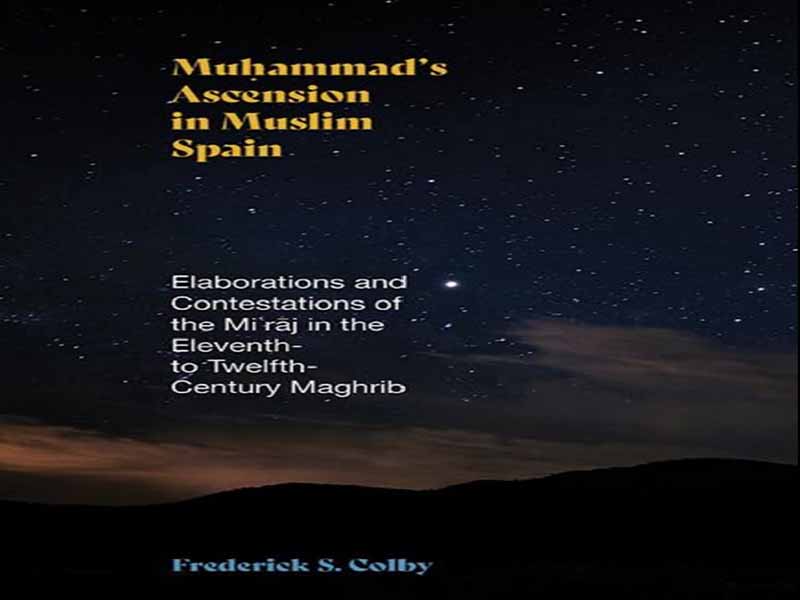- عنوان کتاب: Muhammad’s Ascension in Muslim Spain
- نویسنده: Frederick S. Colby
- حوزه: اسلام
- سال انتشار: 2022
- تعداد صفحه: 180
- زبان اصلی: انگلیسی
- نوع فایل: pdf
- حجم فایل: 5.96 مگابایت
از زمان ظهور اسلام، بسیاری از مسلمانان دوست داشتهاند که داستانهایی از سفر به جهانهای فراتر از این جهان را بازگو کنند، بهویژه روایتهایی که سفر افسانهای محمد در آسمانها در سفر شبانه (اسراء) و معراج (معراج) او را توصیف میکنند. داستانی پر از اهمیت برای دانشمندان نخبه – از سنت گرایان و متکلمان گرفته تا مفسران، فیلسوفان و عارفان – و نیز مؤمنان معمولی، سفر محمد از سال های اولیه به عنوان یک بوم بهشتی عمل می کرد که نویسندگان مسلمان بعدی دوره پیشامدرن می توانستند روی آن ظروف آسمانی، باغ ها، تصاویر ملموس از آتش را به تصویر بکشند. تاج و تخت، و حتی گاهی خود خدا. این «روایتهای معراج» در هر جایی که مسلمانان زندگی میکردند و سفر میکردند، پخش میشد و حکایتها، داستانها و تکههای داستانی را از انبوه نسخههای رقیب که در گزارشهای شفاهی و مکتوب نقل شدهاند، به هم میپیوندند. در هر مورد، روایت داستان با زبانها، ترانهها، و دغدغههای زمینههای محلی که در آن کسانی که داستانها را انتقال میدادند، روایتهای خود را بیان میکردند، در تعامل بود. این کتاب حکایت رشتههای منتخبی از تار و پود تاریخ خاص روایتهای معراج مسلمانان در غرب مدیترانه است، در میان روایتهایی که از اسپانیا و شمال آفریقا در قرون وسطی برخاستهاند، و بهویژه آن دسته از دانشمندانی است که متخصصان معاصر بعداً آنها را به عنوان «متفکران» طبقهبندی کردند. با روایات اخروی در میان هم عصران یهودی و مسیحی خود. تعدادی از آنها همچنین برخی از گفتمان های مسیحایی و آخرالزمانی رژیم های اصلاح طلب مسلمان را که بر بیشتر منطقه ای در جنوب اسپانیا و مراکش کنونی حکومت می کردند، انتخاب کردند. در مجموع، این نویسندگان متفکر مسلمان «مغربی» (به معنای «غربی» در سرزمینهای غربی اسلام) نقش تعیینکنندهای در شکلدهی خطوط افسانه محبوب عروج محمد (ص) ایفا کردند که قرنها پس از آن به طور عمومی منتشر میشد. تاریخ و توسعه روایات معراج مسلمانان موضوع توجه دانشمندان فزاینده در دهههای اخیر بوده است. بسیاری گمان میکنند که یک داستان متعارف معمولی از عروج محمد وجود دارد که میتوان آن را شناسایی و طبقهبندی کرد، با گفتهها و تفاسیر دیگری که بر اساس وفاداری یا انحراف آنها از این نسخه ادعایی «ارتدوکس» سنجیده میشود. این مطالعه با بررسی خلاقیت و گستردگی گزارشها و تفسیرهای مکتوب درباره سفر شبانه و معراج در آثار علمی در غرب مسلمان، عمدتاً از منطقه معروف به «مغرب» از قرن یازدهم تا دوازدهم عصر مشترک، بر بینشهای موجود در زمینههای مطالعات روششناختی و مطالعات اخیر اسلامی مبتنی است. هترودوکسی که در داستان های معراج به کار می رود سزاوار بازنگری ما است و نقش مفسران مغربی در بسط نسخه های کلیدی داستان مستحق توجه بیشتر است. به طور خاص، می توان دید که چگونه بحث ها در این دوره در مورد سفر بهشتی محمد که با برخی از ژرف ترین متفکران متفکر پیشامدرن در اسپانیا امروزی، مانند ابن براجان (متوفی 536/1141)، ابن قاسی (د. 5146/513) و ابن اعظم (د. 5146) و ابن اعظم (د. 5146/1) آغاز می شود، آغاز می شود. (متوفی 638/1240)، خلاقانه تأمل میکنند و با بحثهایی که در آن زمان برجسته بود، گفتگو میکنند: چه کسی از رهبری فرستاده الهی جامعه برخوردار است؟ چگونه جوامع مذهبی با یکدیگر و با لشکر فرشتگان خدا ارتباط دارند؟ چگونه چنین مسائلی با انتظارات قریب الوقوع پایان زمان آینده مرتبط است؟ این اثر با بررسی طیف وسیعی از منابع مغربی از گونههای مختلف، از تفاسیر قرآن، سیره نبوی (ادبیات سیره) و آثاری که صرفاً به سخنان حضرت محمد (ص) اختصاص داده شده است (گزارشهایی که در حدیث عربی در مفرد نامیده میشوند، از احادیث الأخر تا الأخر) به دنبال پاسخ به این سؤالات است: رسالههای عرفانی و داستانهای تمثیلی، تا نشان دهد که چگونه مسلمانان گوناگونی در این زمینه فرهنگی خاص، به بحث، پرداختن و بیان نسخههای رقیب داستان عروج محمد (ص) پرداختند. منابع در نظر گرفته شده در این پژوهش به طور کامل یا جزئی داستان این سفر خارق العاده را روایت می کند که گفته می شود پیامبر در میانه سیره نبوی خود تجربه کرده و آن را با نیازهای کنونی خود تطبیق داده و مرزهای آن را خلاقانه کشف کرده است.
Since the rise of Islam, many Muslims have loved to recount stories of journeys to other worlds beyond this one, especially narratives that describe Muḥammad’s fabulous trip through the heavens during his night journey (isrāʾ) and ascension (miʿrāj). A tale full of significance to elite scholars — from traditionists and theologians to exegetes, philosophers, and mystics — as well as common believers, Muḥammad’s journey from the earliest years served as a heavenly canvas on which subsequent Muslim writers of the premodern period could paint tangible images of angels, gardens, fires, oceans, veils, the divine throne, and even at times God himself. These “ascension narratives” spread wherever Muslims lived and traveled, weaving together anecdotes, storylines, and narrative fragments from the wealth of competing versions that have been passed down in both oral and written accounts. In each case, the telling of the tale engaged and interacted with the languages, tropes, and concerns of the local contexts in which those who transmitted the stories articulated their accounts. This book is the tale of select strands of the fabric of the particular history of Muslim ascension narratives in the western Mediterranean, among those arising out of medieval Spain and North Africa, and especially those of scholars whom contemporary specialists would later come to categorize as “contemplatives.”1 These western Mediterranean authors approached the ascension tale from a particular direction, interacting and competing with otherworldly narratives among their Jewish and Christian contemporaries. A few of them also co-opted some of the messianic and apocalyptic discourses of the Muslim reformist regimes that ruled much of the region of what is now southern Spain and Morocco. As a whole, these “Maghribī” (meaning “western” in the sense of the western lands of Islamdom) Muslim contemplative authors came to play a decisive role in shaping the contours of the beloved legend of Muḥammad’s ascension as it was popularly circulated for centuries thereafter. The history and development of Muslim ascension narratives has been the subject of increasing scholarly attention in recent decades.2 Nevertheless, most studies to date have focused on the accounts composed by a single individual author, or delved into a narrow range of ascension-related themes. Many presume that there is one standard mainstream canonical story of Muḥammad’s ascension that can be identified and classified, with other tellings and interpretations measured by their faithfulness to or divergence from this allegedly “orthodox” version. By examining the creativity and expansiveness of written accounts and commentaries about the night journey and ascension in scholarly works in the Muslim West, primarily from the region known as the “Maghrib” from the eleventh through the twelfth centuries of the Common Era, this study builds on the insights of recent methodological works in the field of Islamic studies to argue that previous conceptions of orthodoxy and heterodoxy as applied to the miʿrāj tales deserve our reconsideration, and the role of Maghribī commentators in the development of key versions of the tale merit much greater attention. Specifically, one begins to see how the discussions in this period regarding Muḥammad’s heavenly journey that originate with some of the most profound premodern contemplative thinkers in what is modern-day Spain, such as Ibn Barrajān (d. 536/1141), Ibn Qasī (d. 546/1151), and the “Grand Master” Ibn ʿArabī (d. 638/1240), creatively reflect and are in dialogue with debates that were salient at the time: Who enjoys divinely sent leadership of the community? How do religious communities relate to one another and to God’s angelic hosts? How do such issues relate to the imminent expectation of the coming End of Times? This work seeks answers to such questions by surveying a range of Maghribī sources from different genres, from Qurʾān commentaries, prophetic biographies (sīra literature), and works dedicated solely to the sayings of the Prophet Muḥammad (reports called in Arabic hadith in the singular, āḥādīth in the plural; hereafter: “hadith” for both) to broader learned mystical treatises and allegorical tales, to show how a variety of Muslims in this specific cultural context debated, delved into, and told competing versions of the story of Muḥammad’s ascension. The sources considered in this study narrate in whole or in part the story of this extraordinary journey that the Prophet was said to have experienced in the middle of his prophetic career, adapting it to their present needs and creatively exploring its boundaries.
این کتاب را میتوانید از لینک زیر بصورت رایگان دانلود کنید:
Download: Muhammad’s Ascension in Muslim Spain



































نظرات کاربران